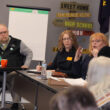Sean C. Morgan
The Sweet Home City Council will consider whether to allow the use of side-by-side all-terrain vehicles on city streets at an upcoming meeting.
The council directed staff during its regular meeting on March 26 to prepare an ordinance for its consideration.
Based on input from members of the public, the council had requested information about the use of ATVs on roadways.
Police Chief Jeff Lynn outlined what he has learned about the issue.
On June 22, 2017, Gov. Kate Brown signed Senate Bill 344, expanding the use of ATVs on highways, effective Jan. 1, 2018, Lynn said. The bill also established an ATV Access Routes Advisory Committee, which was charged with designating ATV access routes throughout Oregon where individuals may operate ATVs within a portion of the highway right-of-way.
Class IV vehicles, also known as side-by-sides, have four tires with a rim diameter of 14 inches or less, Lynn said. They are designed for cross-country travel, have non-straddle seating, weigh less than 1,800 pounds and are 65 inches wide or less.
A person operating a side-by-side on a public road must be 16 or older, with a valid driver’s license and a Class IV ATV operator permit, Lynn said. The driver and passengers must wear a safety belt or harness and wear a helmet. ATVs operating on a paved road must have ATV safety equipment, including lights for use after dark.
While off road, ATVs are exempt from the liability insurance that is required when they are used on roads, Lynn said. Under the state law, road routes must be posted with signs designating it as an ATV highway access route.
Oakridge passed an ordinance Feb. 15, 2018 authorizing the use of Class IV all-terrain vehicles on city streets, subject to state law.
Lynn said he reached out to the Oakridge police chief, who had no concerns about the ordinance after a year. Under a Sweet Home ordinance, ATVs would continue to be prohibited on Highways 20 and 228.
They would be allowed on local city streets, Lynn said. Provisions in state law allow for crossing state highways at 90-degree angles.
The council gave its consensus to prepare an ordinance proposal. The council must read the ordinance three times over the course of three meetings. It must be read out loud in its entirety at the first reading and then by title only the second and third time. It may approve an ordinance after the third reading. It takes effect 30 days after council approval and the mayor signing the ordinance.
With an emergency clause, the first and second readings can be held the same day and take effect immediately upon the mayor’s signature.
Present at the meeting were Cortney Nash, Susan Coleman, Lisa Gourley, Mayor Greg Mahler, Diane Gerson, James Goble and Dave Trask.




